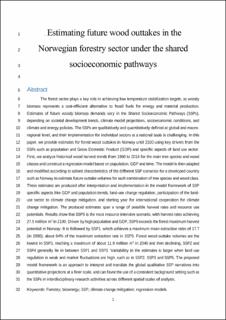| dc.description.abstract | The forest sector plays a key role in achieving low temperature stabilization targets, as woody biomass represents a cost-efficient alternative to fossil fuels for energy and material production. Estimates of future woody biomass demands vary in the Shared Socioeconomic Pathways (SSPs), depending on societal development trends, climate model projections, socioeconomic conditions, and climate and energy policies. The SSPs are qualitatively and quantitatively defined at global and macro-regional level, and their implementation for individual sectors at a national basis is challenging. In this paper, we provide estimates for forest wood outtakes in Norway until 2100 using key drivers from the SSPs such as population and Gross Domestic Product (GDP) and specific aspects of developments in the land use sector. First, we analyze historical wood harvest trends from 1960 to 2016 for the main tree species and wood classes and construct a regression model based on population, GDP and time. The model framework is based on a statistical approach that does not explicitly include market adjustments, but it is adapted to an interpretation of the salient characteristics of the different SSP scenarios to estimate future outtake volumes for each combination of tree species and wood classes in Norway. The SSP characteristics implemented in the model framework are GDP and population, land-use change regulation, participation of the land-use sector to climate change mitigation, and starting year of international cooperation for climate change mitigation. The produced estimates span a range of possible harvest rates and resource use potentials. Results show that SSP1 achieves a maximum mean extraction rate of 17.7 million m3 (in 2090). Forest wood outtake volumes are the lowest in SSP3, reaching a maximum of about 11.9 million m3 in 2040 and then declining. SSP2 and SSP4 generally lie in between SSP1 and SSP3. SSP5 is the most resource intensive scenario, with harvest rates achieving 27.5 million m3 in 2100. Driven by high population and GDP, SSP5 far exceeds the forest maximum harvest potential in Norway. Variability in the estimates is larger when land use regulation is weak and market fluctuations are high, such as in SSP2, SSP3 and SSP5. The proposed model framework is an approach to interpret and translate the global qualitative SSP narratives into quantitative projections at a finer scale, and can favor the use of a consistent background setting such as the SSPs in interdisciplinary research activities across different spatial scales of analysis. | |
